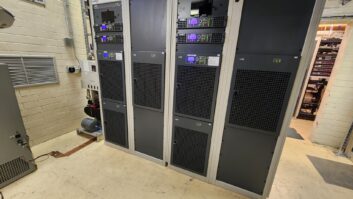In the world of broadcast gear, most of the publicity goes to amazing audio processors, dazzling digital consoles and smaller solid-state transmitters. The lowly FM rebroadcast receiver is one of those staple items that receive little attention from manufacturers — until now. Hot off the show floor from the spring NAB Show is the Inovonics Aaron 650 FM Rebroadcast Receiver. Inovonics has managed to bring this rather pedestrian product class squarely into the 21st century by using cutting edge technology. The device received a Radio World Best of Show award at the spring show.
It should be noted that there is an Aaron 640, a pared-down, value-oriented model, notably lacking some I/O options; here we review the “premium” 650 model.

UP FRONT
The front panel of Aaron has a bright OLED display and jog wheel to access the rather extensive menu. There are two large solid-state VU meters as well as LED indicators for: audio loss, RF loss, RDS loss and stereo pilot. There’s also a 1/4-inch headphone jack. Inserting a plug automatically brings up the headphone volume menu and sets the jog wheel to adjust volume. Finally, there is a slot for SD cards.
Around back there are two N connectors for receiving antennas, XLR connectors for analog left and right out, as well as AES digital out. Two composite outputs are available on BNC connectors. A USB B-type connector delivers the RDS data stream for analysis. Network connections come via a RJ-45 port, useful for remote access via Aaron’s web server, as well as accessing a web stream in failover mode.
Finally, there is a Euroblock connector for alarm tallies, including audio loss, RF carrier loss, loss or “hijacking” of the RDS/RDBS subcarrier and loss of stereo pilot.
Peeking under the top cover, Aaron is a marvel of surface-mount technology, with everything being done by a couple dozen integrated circuits and little else. SMT architecture means there are no tuned circuits. The quality of construction is up to Inovonics’ usual high standards, and you’re covered by a three-year warranty.
Interfacing with Aaron can be accomplished via the front-panel OLED display and jog wheel. The menu for this device is rather extensive however, and you’ll probably want to do the bulk of the setup via the Web browser and laptop or mobile device once the initial IP parameters have been entered.
Most conventional rebroadcast receivers have a composite along with left/right audio outputs. Normally, you connect the composite output to the baseband input of the exciter or translator. With a solid, noise-free signal, this pass-through method works fine, but if the signal is iffy, not so much. Aaron gives you the option of using a stereo-regen mode, in addition to pass-through. With regen, the signal is demodulated down to left and right audio, then re-encoded by dropping the audio into a local stereo generator, resulting in a substantial reduction in noise.
You may make the decision as to which mode to use while setting up Aaron. Simply monitor the off-air signal while switching between the two modes. Aaron can also regenerate a noisy RDS signal, or replace it with one more pertinent in the rebroadcast signal.
Aaron boasts some pretty amazing receiver specs. Unweighted monaural SNR for AES digital and L/R analog line outputs, referenced to ±75 kHz carrier deviation with an RF input level of 60 dBuV is greater than or equal to 82 dB digital, 80 dB analog. With 0 dBuV, SNR is greater than or equal to 43 dB digital/analog.
This receiver owes much of its stellar performance to its software-defined radio architecture. As with most of today’s modulation monitors, as soon as RF enters the box, the signal is digitized. After that, it’s all about coding and DSP.
Aaron’s SDR architecture enables a series of reception tools and visual aids that would not be possible with conventional receivers. Many of these will only work when Aaron is operated in the stereo-regen mode.
First up is IF Bandwidth. In the factory default auto mode, bandwidth is controlled by the composite signal parameters, and maximum bandwidth is maintained consistent with signal quality. In manual mode, it can be adjusted in increments between 56 and 311 kHz.
A suite of three tools are included to compensate for deteriorating signal quality. A traditional stereo blend incrementally changes the reception mode from stereo to mono. Blending may be based upon RSSI (received signal strength), ultrasonic noise or multipath. It’s your choice.
“High Blend” is very similar to stereo blend, but only the higher audio frequencies are blended toward mono. High-cut gradually rolls off high frequencies rather than sacrificing stereo separation. All of these have a series of manual adjustments made through the OLED display or Web access.
Additionally, Aaron offers two more advanced reception tools, “multipath suppression” and “channel equalizer,” that function in both the pass-through and stereo-regen modes. There are no adjustments, they are either on or off.
In the graphs and metering submenu, there are several powerful visual aids to assist with receiver setup. First is MPX-FFT, which will provide a spectral display of the signal leaving the 650. You can determine the injection level of the stereo pilot and all subcarriers, view FM baseband noise and irregularities, and see the effect of different IF bandwidths in the pass-through mode. Viewing this display while switching between pass-through and stereo-regen modes will give you a good idea of how much cleaner one mode is than the other.
BandScanner presents an RF spectrum display of the incoming signal at carrier frequencies, and here you can set the Center Freq of the display, Step Size or resolution bandwidth. In a wide-range analysis, you can see the entire FM band with the individual carriers of stations in your local market.
Processing, the next menu item, displays the real-time action of the three stereo reception tools discussed earlier. These are actually redundant to displays with the reception tools, only these displays have higher resolution, include a peak hold feature, and enable viewing all three displays simultaneously.
XY Plot provides the stereo sum and difference levels on peak-reading bargraphs, as well as the familiar XY scope display. This is useful for visualizing how wide the stereo image is, as well as out-of-phase signals and mono broadcasts.
LR Plot gives an indication of loudness by displaying peak levels for the left and right channels averaged over a 10-second window. The amount of time the program peaks spend at or near 0 dB is a direct indicator of program density.
RDS TREATMENT
Since this product is from Inovonics, you would expect RDS to get the full treatment, and you won’t be disappointed.
There is a comprehensive display of RDS parameters. Additionally, in the RDS Regen mode, you are given four choices regarding the RDS subcarrier:
• Recode RDS simply regenerates and retransmits the incoming RDS signal in its original form
• Re-encoded RDS with new PI code retransmits the incoming signal, but allows users to insert a new PI code, enabling strict adherence to the RDS standards
• Built-in RDS removes the incoming data stream and replaces it with static RDS data that is entered manually
• Built-in RDS with Internet Time additionally inserts the current time derived from the Internet
The USB B connector on the back of Aaron delivers the RDS data stream to a PC for closer inspection. Used in conjunction with the RDS analysis software that can be downloaded for free from Inovonics, a detailed analysis of the RDS signal and content is possible. A company representative adds that Inovonics will make the source code for this software available to anyone who wants to do deep customization.
Even in the best-run stations, stuff happens, and your receiver may lose the signal from time to time. Aaron has got you covered with two menu-selectable options: failover to your Web stream via the rear IP connection, or switch to backup audio from the SD card inserted in the front panel. Either WAV or MP3 formats may be used. The 650 will play the audio files in the order they were recorded. After that, it will repeat until the receive signal is restored. A 32 GB card, SDHC type with 128 kbps MP3 file will play for 24.25 days without repeating.
Unfortunately, your backup audio choices are an either/or situation. It would be better, for example, if the user could designate the Web stream as a first option, with the SD card as a secondary choice if the stream is unavailable, a likely scenario at deep remote locations. An Inovonics representative indicates that this type of failover option should be available in an upcoming firmware release.
When stuff happens, you also need to be notified, and the 650 has ample alarm options. Tallies for audio loss, RF loss, loss, “hijacking” of the RDS subcarrier and pilot loss, are available as either active-high or active-low outputs on the rear panel, as well as through the Web browser, which can deliver email and test alerts. The parameters of each of the four alarms may be fine-tuned when the receiver is set up.
The 53-page manual that comes with Aaron is complete and well written. It is worth reading; this is a sophisticated piece of equipment. While it’s possible to get simpler gear running by blundering around with it, you will not reap all the benefits of Aaron if you take this set-it-and-forget-it approach. Most important is taking time to study the menu tree, as this will give you the quickest overview of the setup and options. It can also serve as a handy checklist to make sure you didn’t miss anything while installing Aaron.
All very interesting, but the real question is: How well does it work in the field?
From our hilltop location in central Pennsylvania, distant stations from Pittsburgh, 180 miles away, and Philadelphia, 120 miles away, were tuned in, as well as a few around 50 miles distant. A directional FM antenna was rotated for maximum signal strength. The tests lasted about three weeks.
Having listened previously with an older analog tuner, the difference in the number of stations received was impressive. The signal quality was not that great on many of the test stations, but that’s where the stereo-regen mode works its magic. Signals that you would never consider rebroadcasting in pass-through mode can be cleaned up enough to air using Aaron’s toolbox, and the MPX-FFT display confirms what your ears are already telling you.
On the more distant stations, there was occasional fade and flutter, but this was probably caused by summertime atmospheric inversions and aircraft taking off from the nearby airport. Stations within a 50-mile radius maintained a quality signal in the stereo-regen mode. One might expect slightly better performance from this location with a tower and high-gain antenna cut for the receiving frequency.
Product Capsule
INOVONICS AARON 650
Rebroadcast Receiver
Thumbs Up
+ All-digital SDR (software-defined radio) design
+ Software reception tools enhance marginal signals
+ Multiple alarms local and remote, email and text notification
+ Webstream and SD card failover options
Thumbs Down
– Only one failover option at a time
MSRP: $2,390
CONTACT: For information, contact Lukas Hurwitz at Inovonics in California at (831) 458-0552 or visit www.inovonicsbroadcast.com.
Tuning up Aaron for the best receive signal is a bit like tuning up an audio processor. There is no one right way to do it. There are a number of tools at your disposal, and engineers may take different strategies and settings, yet end up with comparable results.
To sum it up, stations with translator networks have had little incentive to upgrade their gear in the past. Incremental improvements in analog receivers probably weren’t worth the time, money or trouble. Aaron, on the other hand, is a game changer. With its stereo-regen mode, reception tools and displays, it can make definite improvements on signals that have always been marginal. Sites that have not been considered for translators before because they are too remote might now be on the table.
Having spent several weeks evaluating the Aaron 650 rebroadcast receiver, one question remains. Where did the name Aaron come from? Company President/CEO Ben Barber explains: “Aaron comes from a play on words, ‘on air,’ to ‘AirOn,’ or Aaron.”
Tom Vernon is a long time contributor to RW. He keeps busy writing tech manuals and doing market research for several broadcast manufacturers.












